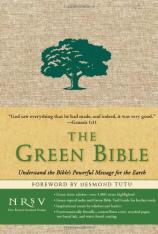The Green Bible: Understand the Bible's Powerful Message for the Earth
Review
The Green Bible: Understand the Bible's Powerful Message for the Earth
You’ve probably heard of a red-letter Bible, but how about a green-letter one? THE GREEN BIBLE (NRSV) highlights in green ink more than 1,000 scriptural references that address creation care in some way, from God’s love for the earth and its creatures to a Christian’s responsibility as stewards of the environment. It’s a great concept, and publisher HarperOne pulls out all the stops in helping Christians to understand their spiritual mandate to care for creation.
HarperOne has obviously put a lot of thought into this Bible; not just the content, but also the execution. It’s printed (in a somewhat vaguely stated “eco-friendly” process) using soy-based inks on recycled paper. The flexible cover is somewhere between a hardcover and a paperback; it’s 100% cotton/linen (avoiding controversial leather; the Bible is endorsed by the director of the Animals and Religion Program of The Humane Society).
The colored ink is helpful, but the varied essays that introduce the scriptures from a broad range of Christian and Jewish traditions are worth the cost of the Bible. Some of the more high-profile essay authors include the late Pope John Paul II, Archbishop Desmond Tutu (who contributes the foreword), Anglican Bishop of Durham, England, N.T. Wright, and emergent writer Brian McLaren.
I found “Reading the Bible through a Green Lens,” an essay by conservationist Calvin B. DeWitt, most helpful in use with the creation-care ministry in my church. In the essay, DeWitt addresses the most common arguments Christians make against creation care. Among those, he includes: “Since we’re headed for heaven anyway, why take care of creation?”; “There are too many worldly people out there doing environmental things”; “I don’t want to be an extremist or an alarmist”; “People are more important than the environment”; and “I disagree with what some environmentalists and scientists say will happen.” For these and other questions, he offers sensible, clear refutations.
DeWitt argues that Christians must become aware of creation (allowing ourselves time for reflection and quiet), appreciate creation (as God values his works) and become a good steward of creation (“we work for the restoration of what has been degraded in the past”). This essay is a great starting point for those engaging with creation care for the first time, or those working in creation care ministry.
Another thought-provoking essay comes from Gordon Aeschliman. “Loving the Earth is Loving the Poor” helps Christians understand why taking care of the world is also a work of justice. Genesis 2:15 calls us to “keep” the garden, he says, noting that the word “keep” is the same as the one used in the Numbers 6:24 blessing, “The Lord bless you and keep you.” In the way the Lord keeps us, we are to keep the earth.” Now that’s an eye-opener.
The features of THE GREEN BIBLE include a historical overview on the church’s teachings on creation care, study guides useful for small groups, and a very helpful green subject index. They’ve also amassed a varied list of endorsements, from Carl Pope, the executive director of the Sierra Club, to Ecumenical Patriarch Bartholomew, the leader of the Eastern Orthodox Church, who has a strong environmental platform in his ministry.
As it says in THE GREEN BIBLE, when Martin Luther was asked what he would do if Jesus was coming tomorrow, he responded, “Plant a tree.” It’s time for Christians to become good stewards of the beautiful world God has entrusted us with --- and THE GREEN BIBLE is a great resource to get started.
Reviewed by Cindy Crosby on October 7, 2008
The Green Bible: Understand the Bible's Powerful Message for the Earth
- Publication Date: October 7, 2008
- Genres: Christian, Religion, Spirituality
- : 1440 pages
- Publisher: HarperOne
- ISBN-10: 0061627992
- ISBN-13: 9780061627996




